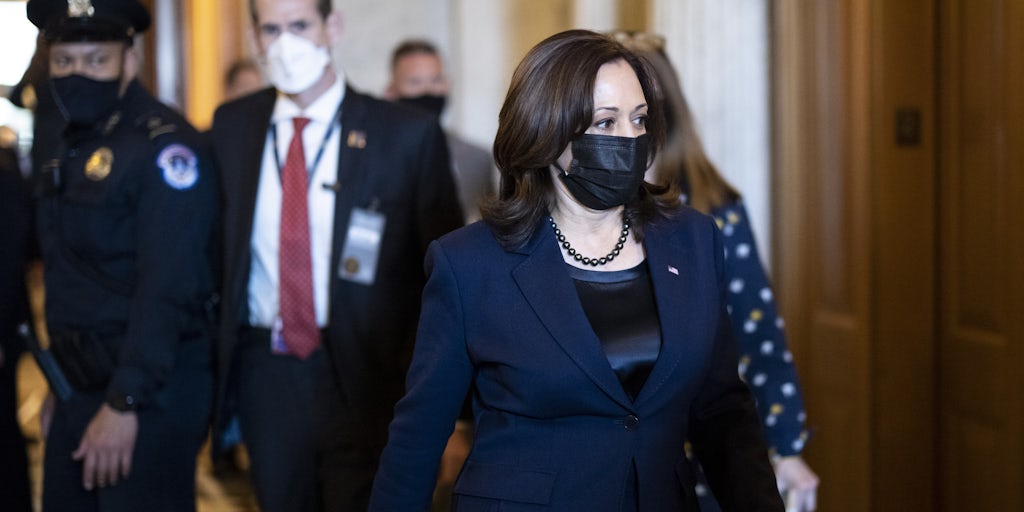Victoria’s Secret Has a New Look – WWD
Victoria’s Secret is giving itself the ultimate makeover.
It includes new marketing campaigns with models of all shapes and sizes, a board made up almost entirely of women (six out of seven) and plans to separate from the Bath & Body Works brand.
It’s a stark contrast for the lingerie business not so long ago known for its near-perfect Angels and as a brand that carried the unflattering bad rap of catering to the male gaze. In fact, to the naked eye, Victoria’s Secret looks like an entirely different entity, its website sprinkled with images of women of all shapes and sizes.

Paloma Elsesser in Victoria’s Secret’s spring 2021 swimwear campaign.
Courtesy Photo
But dig a little deeper and many of the waif-like models are still there. Some of them, anyway. So is the limited size range. The question now is, will consumers respond to the reimagined brand? Or have shoppers become jaded by decades of being told they’re not good enough?
“Based on what women told us — talking to women over the last year and a half even more to understand where we had gotten off track as a brand and how we need to show up for women going forward — is that they want us to change,” Martha Pease, Victoria’s Secret’s chief marketing officer, told WWD. “The answers we got back had to do with representing a diverse way of thinking and relating to women, and showing more types of women, so that all types of women could see themselves in the brand. I think the challenge for us is actually delivering on it. By making this very public statement that we are committed to the transformation and we’re committed to showing up for women means we have to do it.”

Eileen Gu for Victoria’s Secret.
Courtesy Photo
As for extended sizes — something that has become a bit of a hot button in the fashion industry — Pease said the process is “underway,” although there was no set date for when consumers will see larger sizes in stores.
But she added, “There’s a set time frame for transformation. Size is obviously a big part of that equation. We are leaning into it.”
That’s good news for Victoria’s Secret, which was on a three-year downhill streak at the start of the pandemic, losing revenues, market share and shoppers to other intimates brands that emphasized inclusivity and comfort. Women, tired of unattainable beauty standards, were voting with their wallets.
In 2015, Victoria’s Secret had 32 percent of the U.S. women’s intimates apparel market, according to Euromonitor International, a market research firm. By the spring of 2020, Victoria’s Secret’s slice of the pie had fallen to just 16 percent of the market, according to The NPD Group’s consumer tracking service.
Despite the complaints from consumers, Victoria’s Secret powered ahead with its usual messaging. As recently as the fall of 2018, Victoria’s Secret threw its annual fashion show extravaganza — complete with super skinny models, scantily-clad attire and a noticeable lack of diversity — a move that many considered tone deaf in light of the #MeToo Movement.
John Mehas, a Tory Burch alum, was hired not long after to turn the brand around. But this did little to help. Especially since others at the top were in the limelight for less than desirable reasons. In November 2018, Ed Razek, former chief marketing officer for L Brands, told Vogue magazine that the brand didn’t have any interest in plus-size or transgender models. The comments sparked a backlash and forced the company to apologize on Instagram. Razek resigned in August 2019.
But even more scarring for the brand was L Brands’ Founder Leslie H. Wexner’s relationship with convicted sex offender Jeffrey Epstein.
Epstein controlled much of Wexner’s fortune for years, including being named trustee of the Wexner Foundation. Many believed Epstein was using his close ties to Wexner and Victoria’s Secret to seduce young women, although Wexner was quick to distance himself from the disgraced financier after Epstein was arrested on sex trafficking charges in July 2019. (Epstein died of an apparent suicide a month later while in jail.)
Wexner, who is also the former chairman emeritus and former chief executive officer of L Brands, revealed in March that he and his wife Abigail would not stand for reelection to the L Brands’ board of directors this year, thereby leaving the company altogether. Longtime L Brands executive Stuart Burgdoerfer, currently serving as executive vice president and chief financial officer of L Brands, also revealed his plans to retire this coming August after completing the spin-off of Victoria’s Secret.
Meanwhile, behind the scenes, L Brands has been hard at work trying to revive the innerwear brand.
In early 2020’s pre-pandemic times, L Brands announced it would sell a majority stake of Victoria’s Secret — which includes the Lingerie, Beauty and Pink divisions — to private equity firm Sycamore Partners for $525 million, an attempt to revive the brand with a little outside help. But the deal fell through amid the pandemic. Three months later, L Brands said it was going it alone and would separate Victoria’s Secret from Bath & Body Works, possibly taking Victoria’s Secret private in an effort to unlock value in the more profitable soap, hand sanitizer and fragrance brand.
This news sparked renewed interest among the investment community. In the months that followed L Brands’ stock surged. (Shares of L Brands, which closed down 5.11 percent Thursday to $62.79 a piece, are now up approximately 302 percent, year-over-year.) So did the value of Victoria’s Secret. The $525 million price tag in early 2020 jumped to a valuation of nearly $5 billion by spring 2021, according to analysts at J.P. Morgan.
Other efforts to return the business to its glory days include adding a string of senior-level hires — including Pease and replacing Mehas with Martin Waters — while updating the assortment and marketing materials. In October 2019, the brand hired its first plus-size model Ali Tate Cutler, followed by its first transgender model, Valentina Sampaio, the following August. Most recently, Victoria’s Secret used nine-month-pregnant model Grace Elizabeth for its Mother’s Day campaign.

Victoria’s Secret used nine-month-pregnant model Grace Elizabeth for its Mother’s Day campaign.
Courtesy Photo
Earlier this year, Victoria’s Secret unveiled the return of swimwear to select stores. In addition, L Brands sold a majority stake of the Victoria’s Secret U.K. business to Next plc and closed hundreds of unprofitable stores to make way for more lucrative markets, such as Milan and Israel.
In the future, Raúl Martinez, creative director at Victoria’s Secret, said the lingerie brand’s brick-and-mortar stores will look different, too.
“Right now they’re being remodeled,” Martinez said. “All the imaginary is down. The pink that is being used is not the pink that’s been there in the past. It’s not that much darker, glossy moment. It’s much more contemporary and lighter and friendlier and more welcoming.”
There’s also talk of bringing back the Victoria’s Secret Fashion Show, possibly in 2022.
“When we do bring something back it’s not going to be the show that was, because the world has changed and entertainment has evolved,” Martinez said. “The evolution of fashion shows in general, I think, everyone is trying to discover what that is, what that experience is. So, what that will look like is what we’re discussing right now.”
Also in Victoria’s Secret’s favor is that it is still the market share leader in the intimates apparel space. Revenues for all of 2020 total $5.4 billion. But that figure includes the effects of the pandemic when nearly all retailers experienced losses. Total revenues in 2019 were $7.5 billion.
“Victoria’s Secret has advantages stemming from its size, customer database and financial resources very few rivals can match,” Jay Sole, an analyst at UBS, wrote in a note. “Stronger-than-expected earnings growth and the upcoming separation of [L Brands] into two separate companies will drive P/E expansion.”
Shoppers are starting to take note, too — at least some of them. In the most recent quarter, revenues at the innerwear brand topped $1.5 billion, with improving comparable sales in stores and online.
“Our business is doing very well,” Pease said. “We have a very healthy business. Our fundamentals are strong. I don’t think there’s any argument for this [transformation] being too late. There’s so much leverage in the brand. There’s so much value yet to be mined and created. I’m focused on the impact that we can have, because of our scale, because of our long-standing credibility as a leader, and because of the intelligence of our strategy and our commitment to making this change and transformation.
“And our plans for the brand going forward are not too little,” she continued. “We don’t tend to do things in small doses. I’m confident that what we’re doing moving forward, the scale of what we’re doing will not be too little to have an impact.”
In fact, even celebrities and high-profile women are starting to once again endorse the brand. On Wednesday, the retailer revealed its latest transformation efforts, The VS Collective. The initiative includes a group of women from diverse backgrounds who will share their stories by way of collaborations, business partnerships, cause-related campaigns and various platforms, such as a podcast and social media.
The Collective’s inaugural line-up consists of mental health advocate and model Adut Akech; World Champion freestyle skier Eileen Gu; professional soccer player and LGBTQ activist Megan Rapinoe; actress and entrepreneur Priyanka Chopra Jonas; media personality and founder of digital media platform Girlgaze Amanda de Cadenet; plus-size model Paloma Elsesser and Victoria’s Secret’s own Valentina Sampaio. Other women may be added over time.
The Collective, Pease said, is what consumers “uniquely expect from us. We’re expected to take a leadership role in bringing new ways of thinking about the world and putting dialogue out there into the world that other brands aren’t expected to kind of create and champion and support.”
Martinez added, “We wanted to bring a diverse group of women with very strong voices and a strong sense of self. If you start being authentic in how you’re communicating and what you’re representing, I think people will see that. And that to me is key to what we’re trying to accomplish here, to change the narrative.
“I don’t think we need to compete [with competitors] to be honest,” he continued. “I think we need to be who we are.”



:quality(70)/cloudfront-eu-central-1.images.arcpublishing.com/businessoffashion/6PZH3VQMMFGQFDYJTJG73DVH6Y.jpg)

